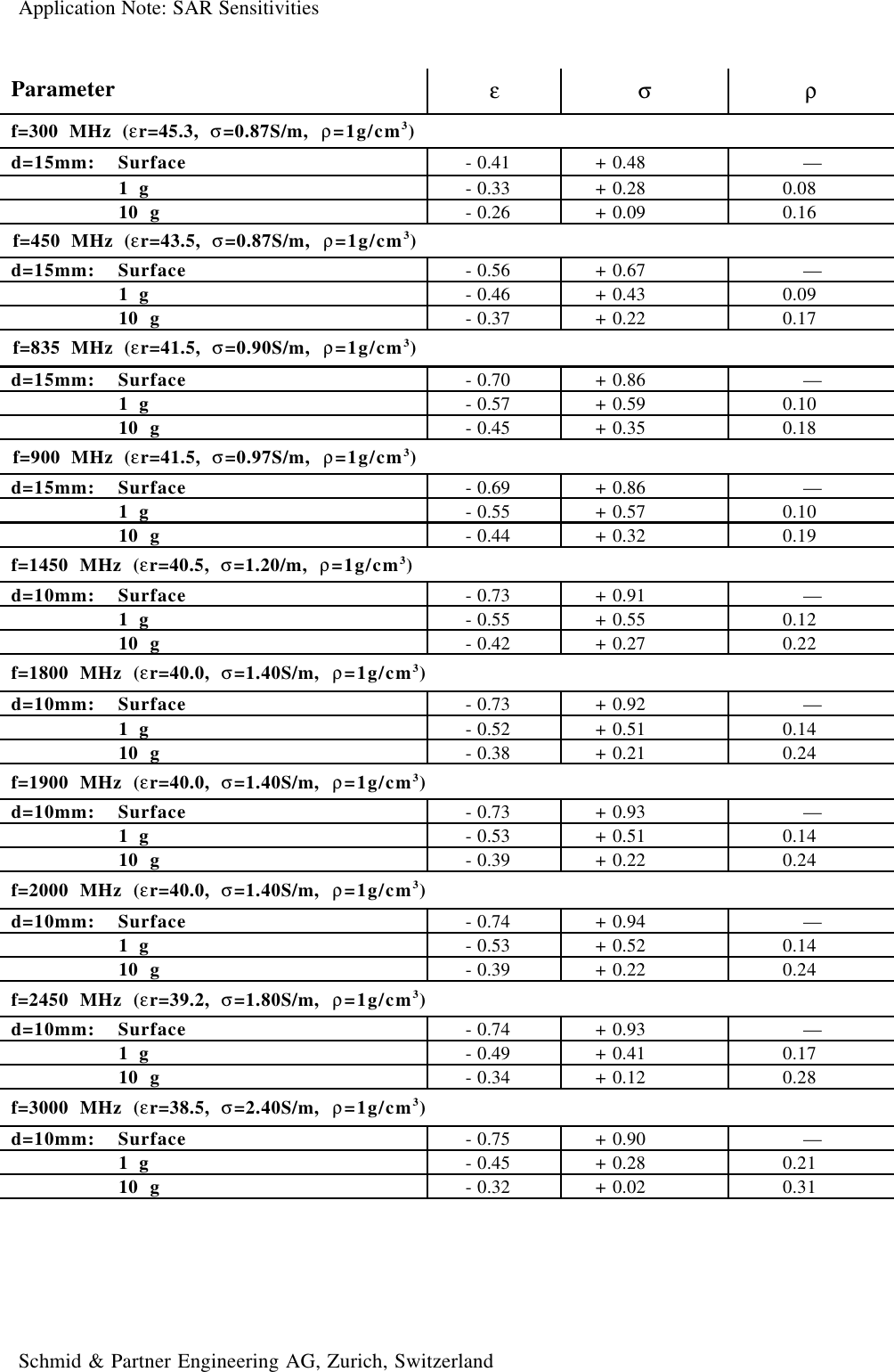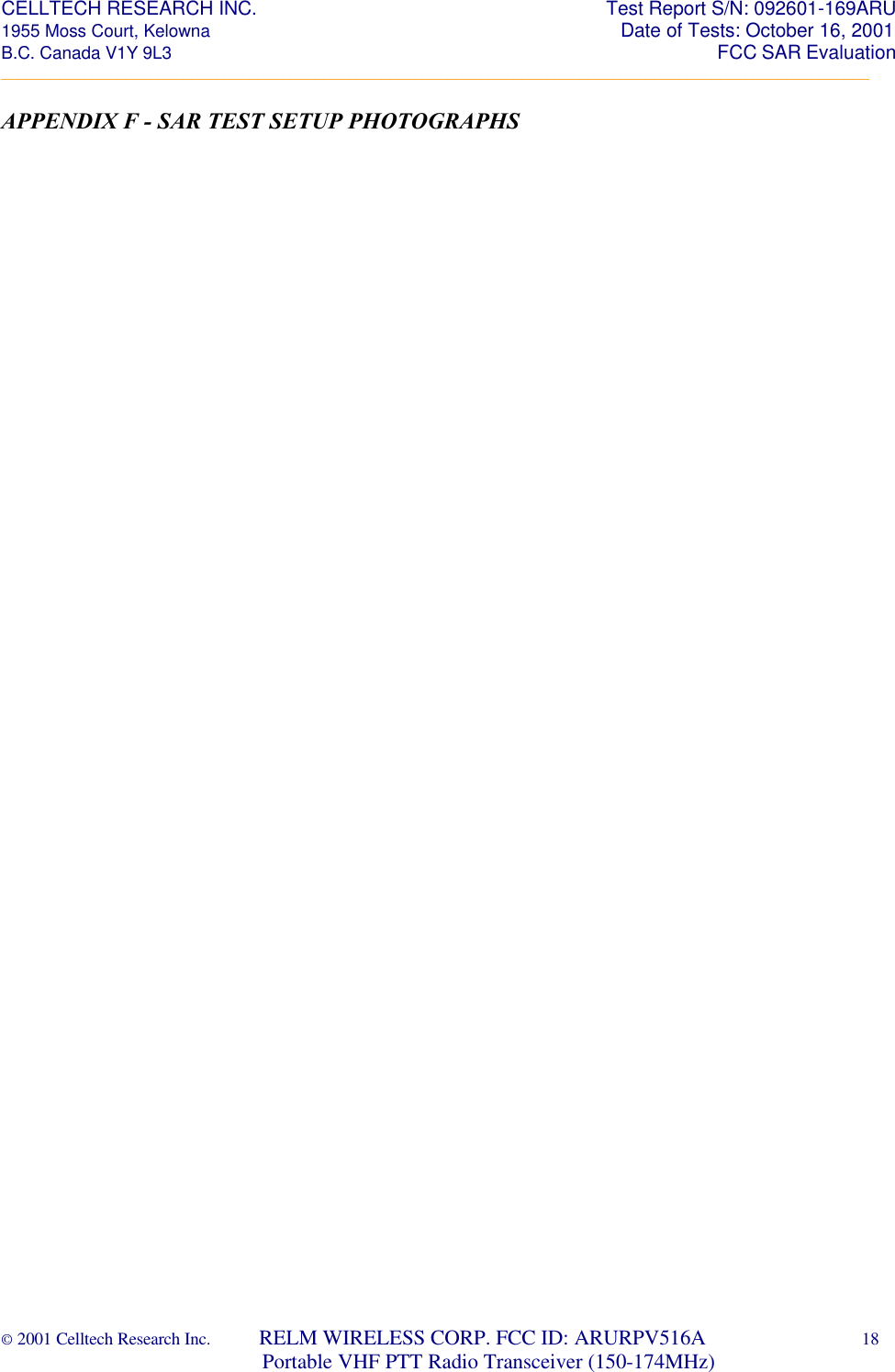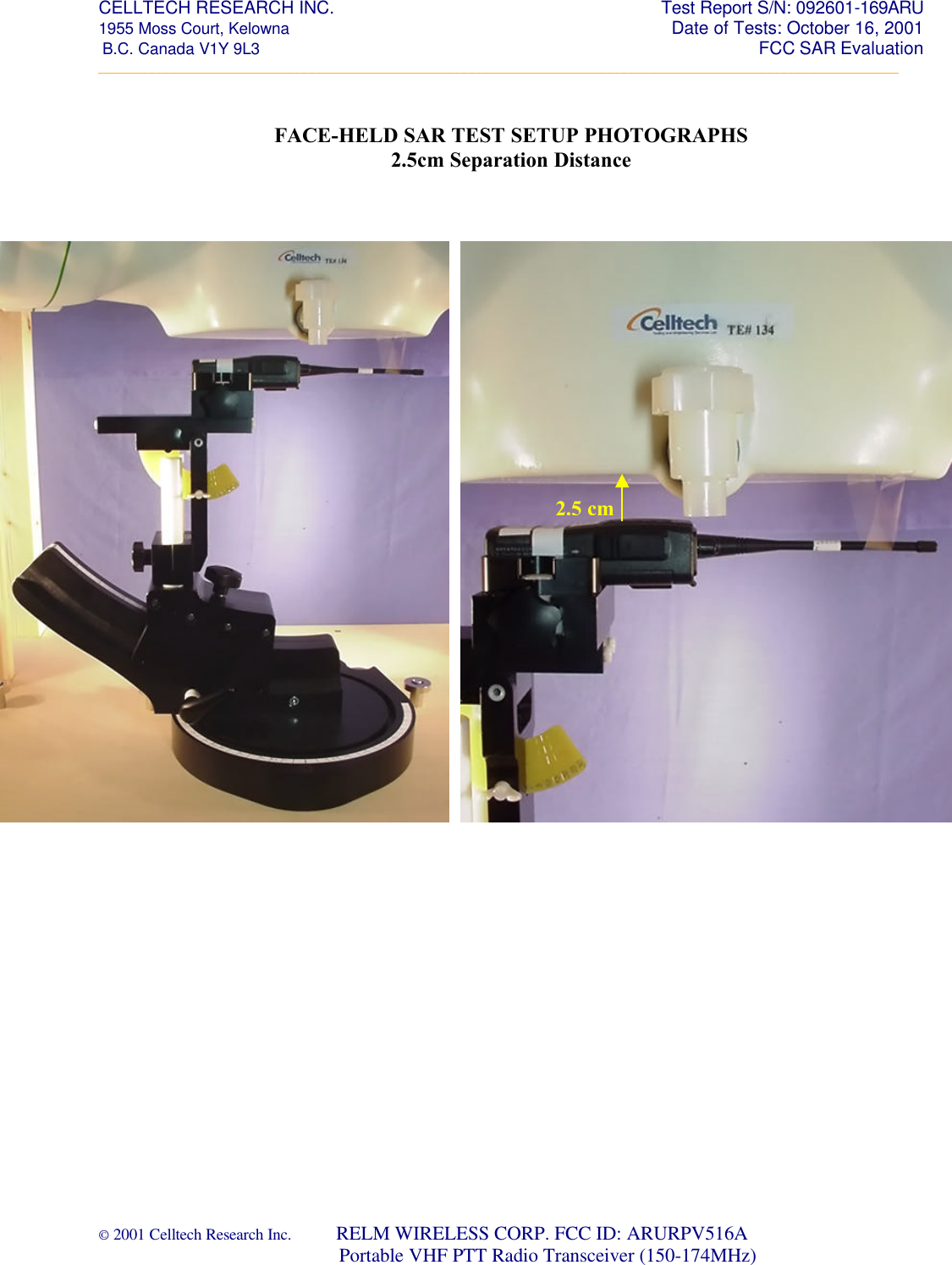RELM Communications RPV516A VHF FM Transceiver User Manual RPV516A SAR Test Report revised 121901
RELM Communications Inc VHF FM Transceiver RPV516A SAR Test Report revised 121901
Contents
- 1. Users Manual
- 2. Revised Manual 121901
- 3. Revised Manual 010402
Revised Manual 121901
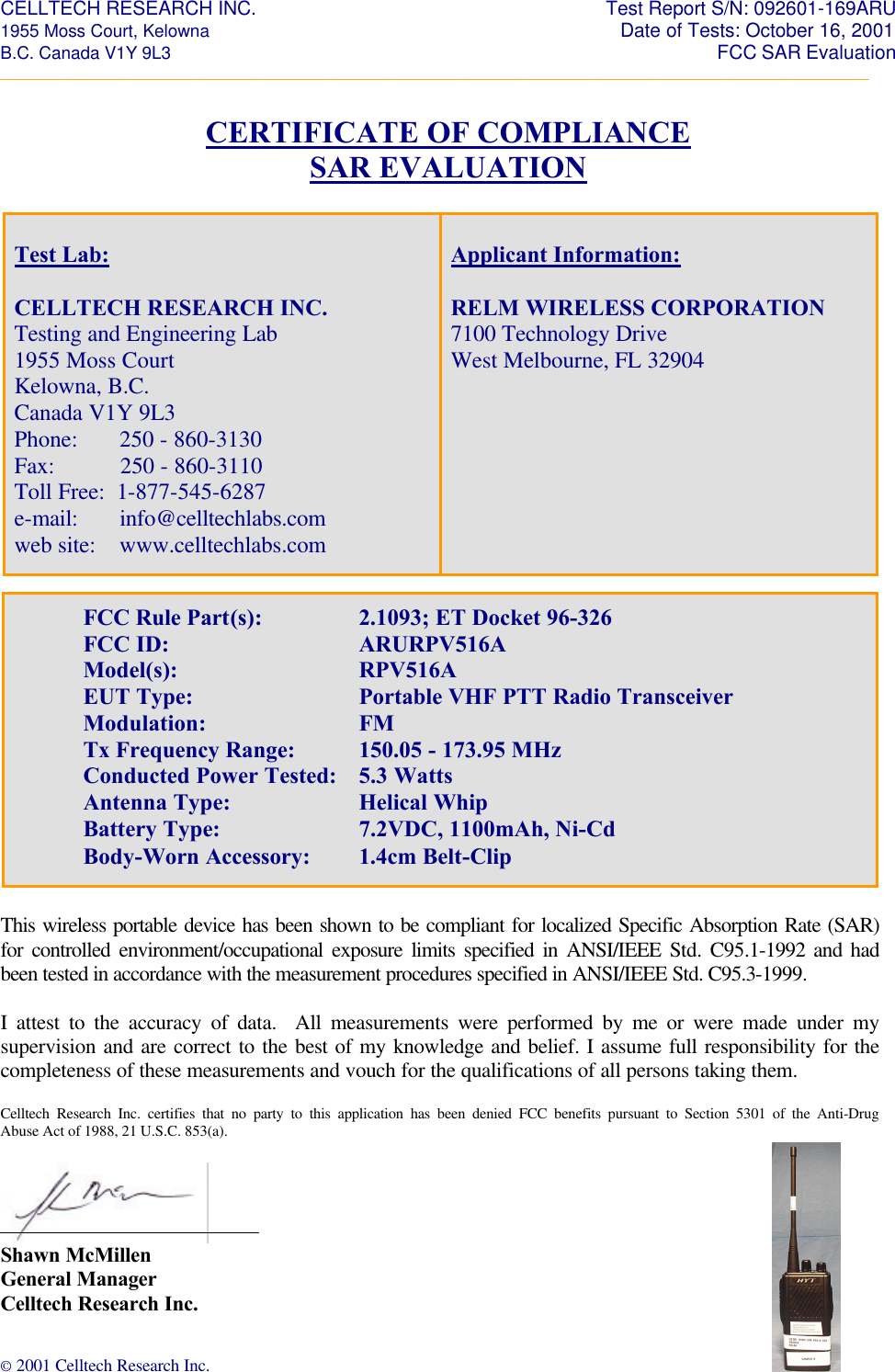


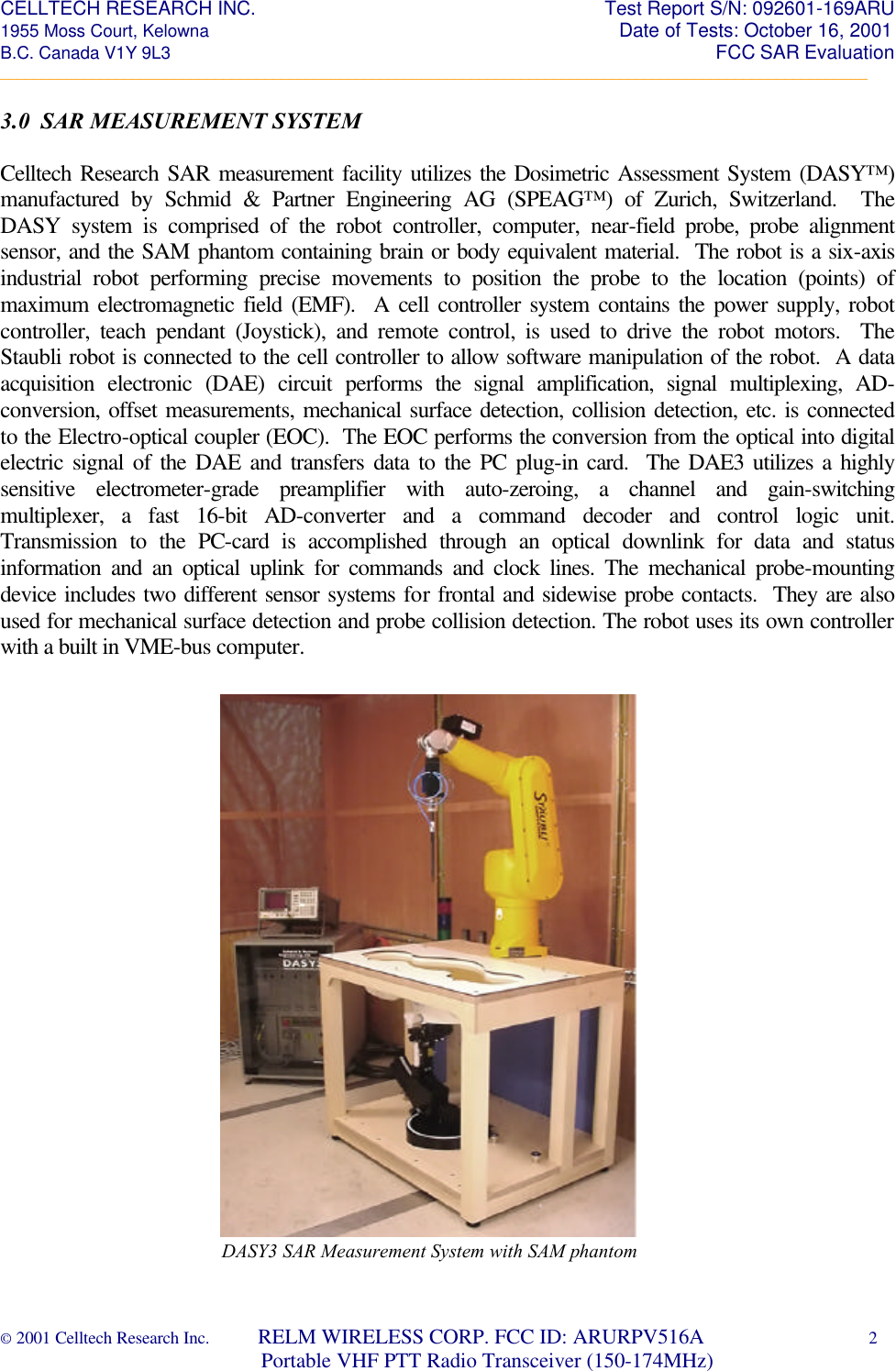


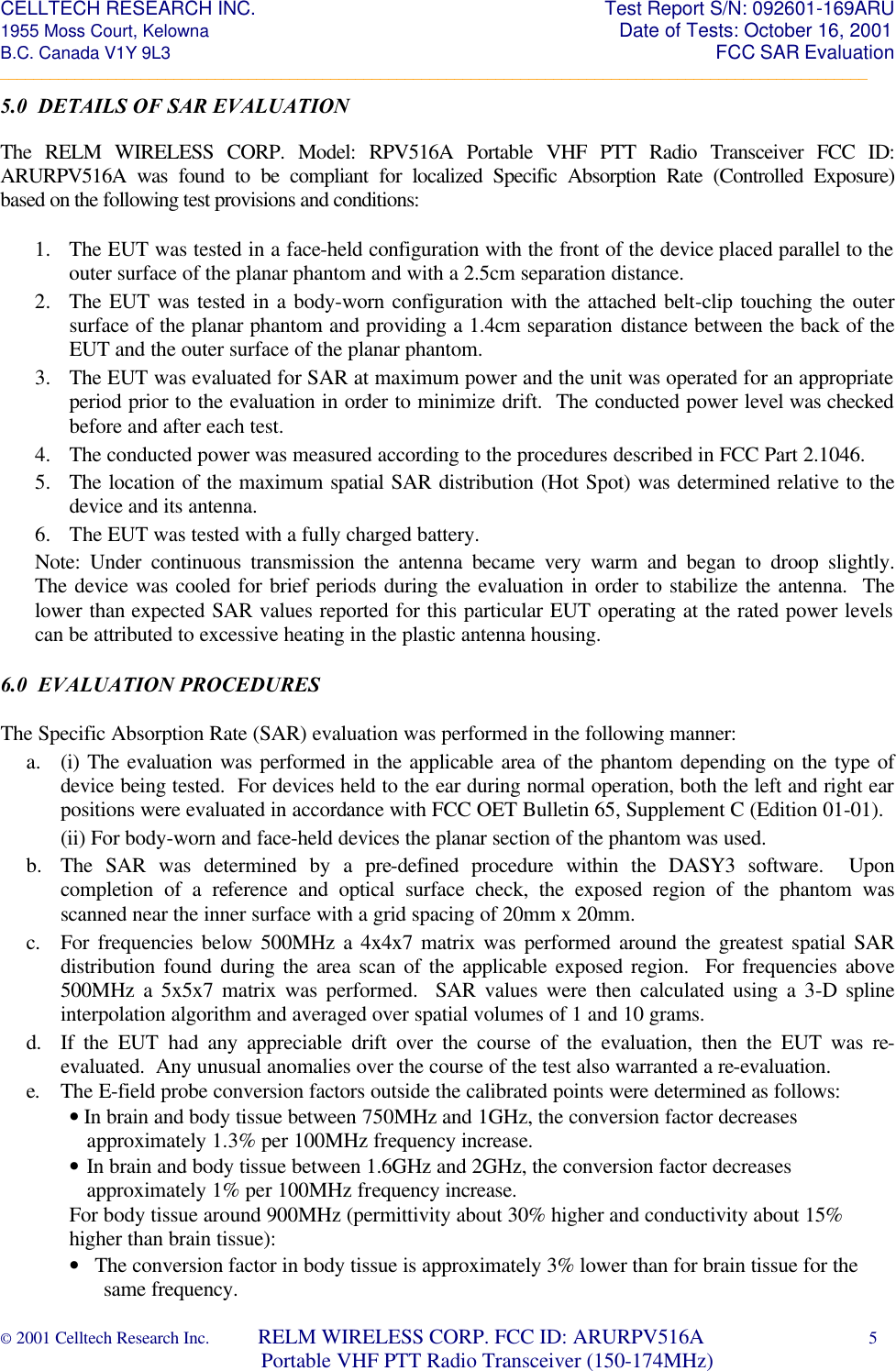
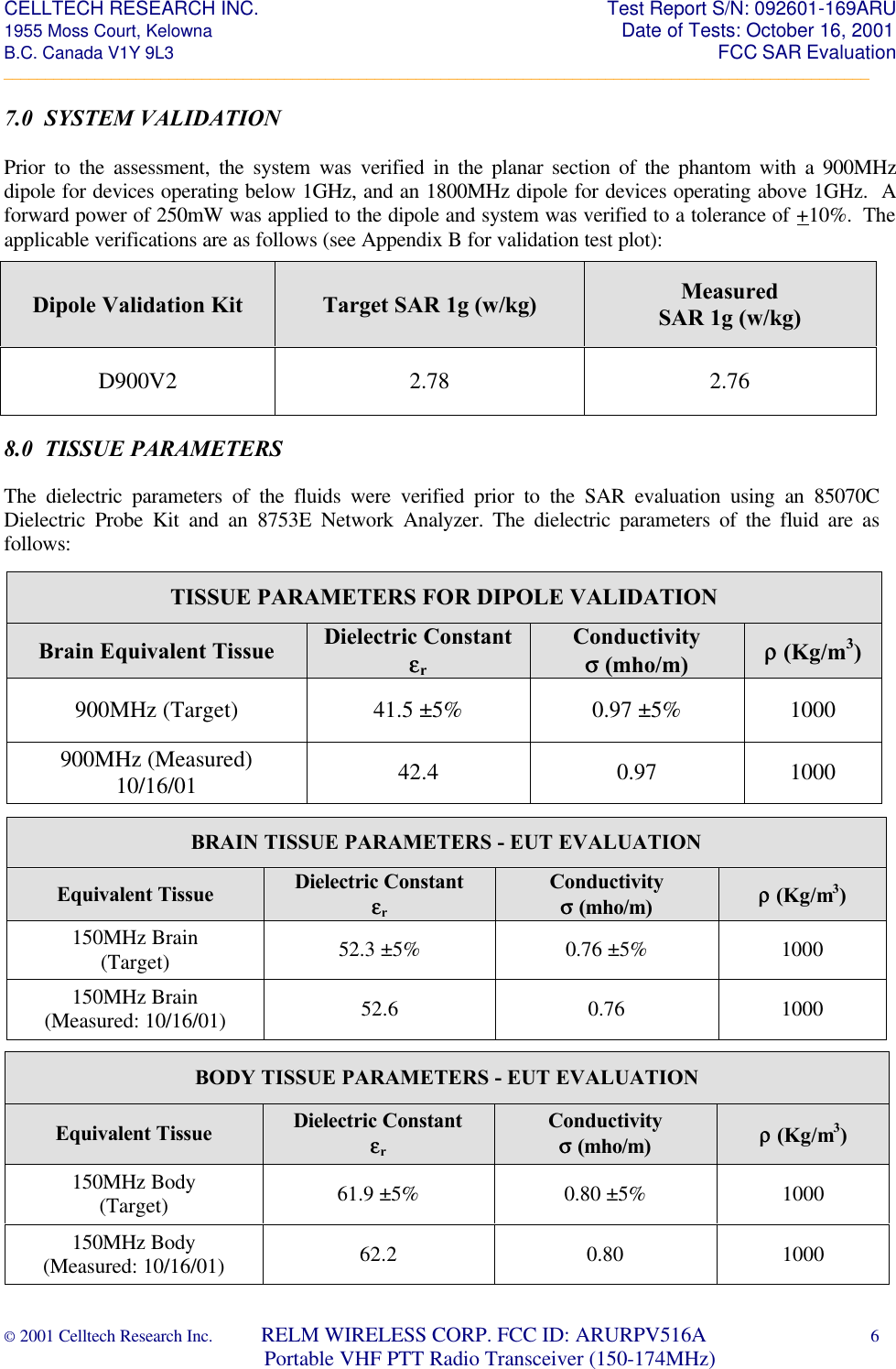
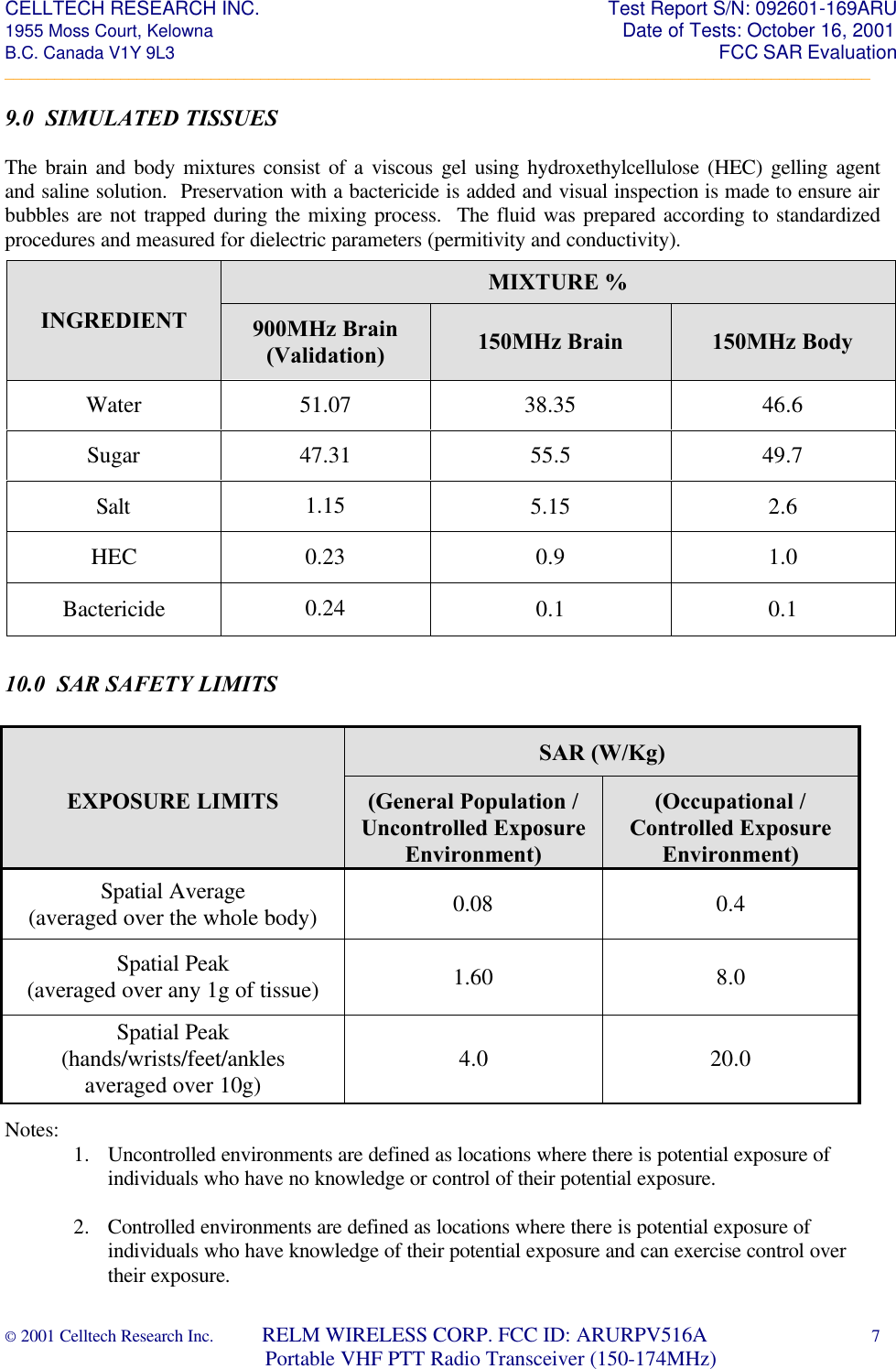

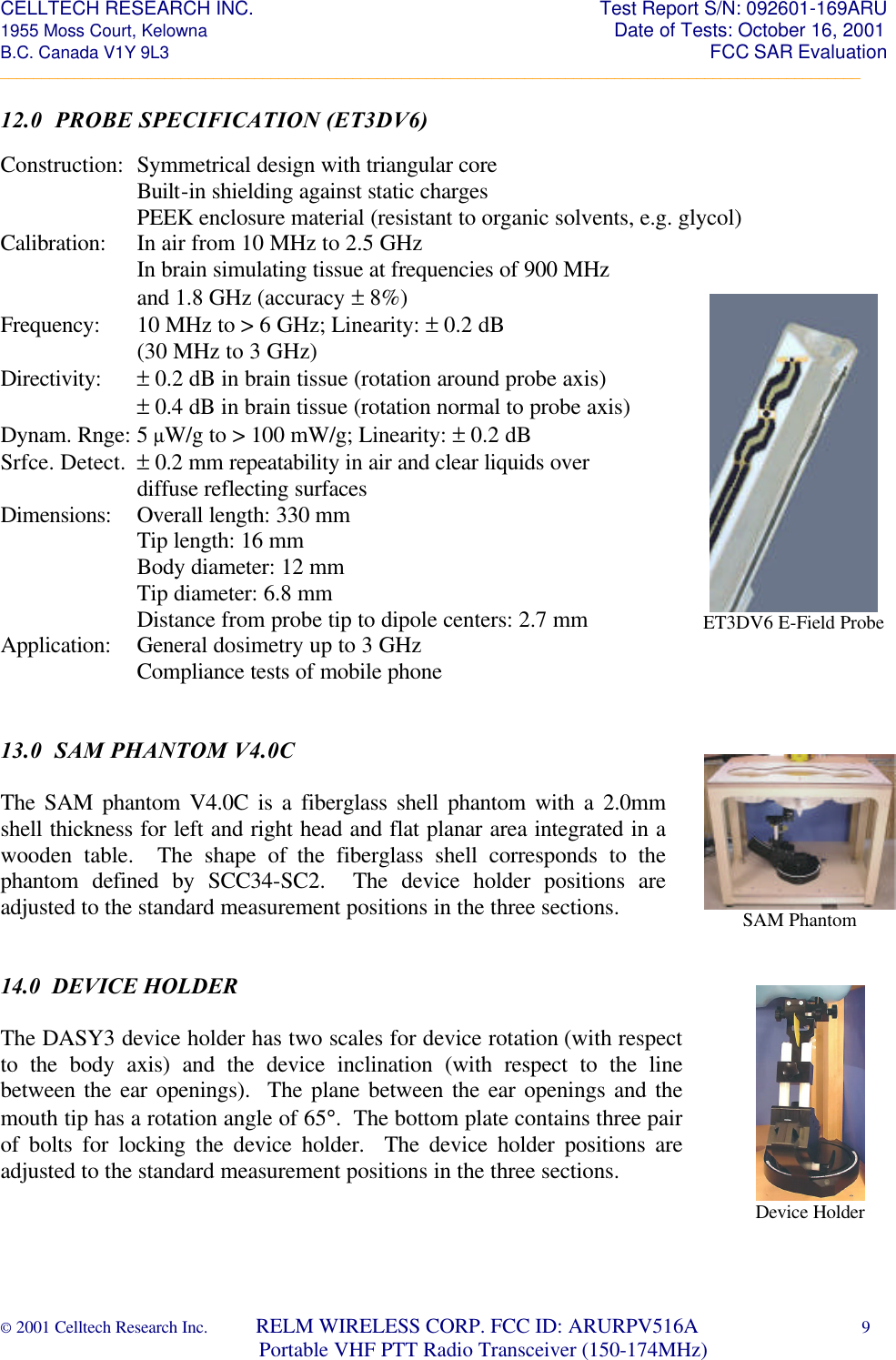



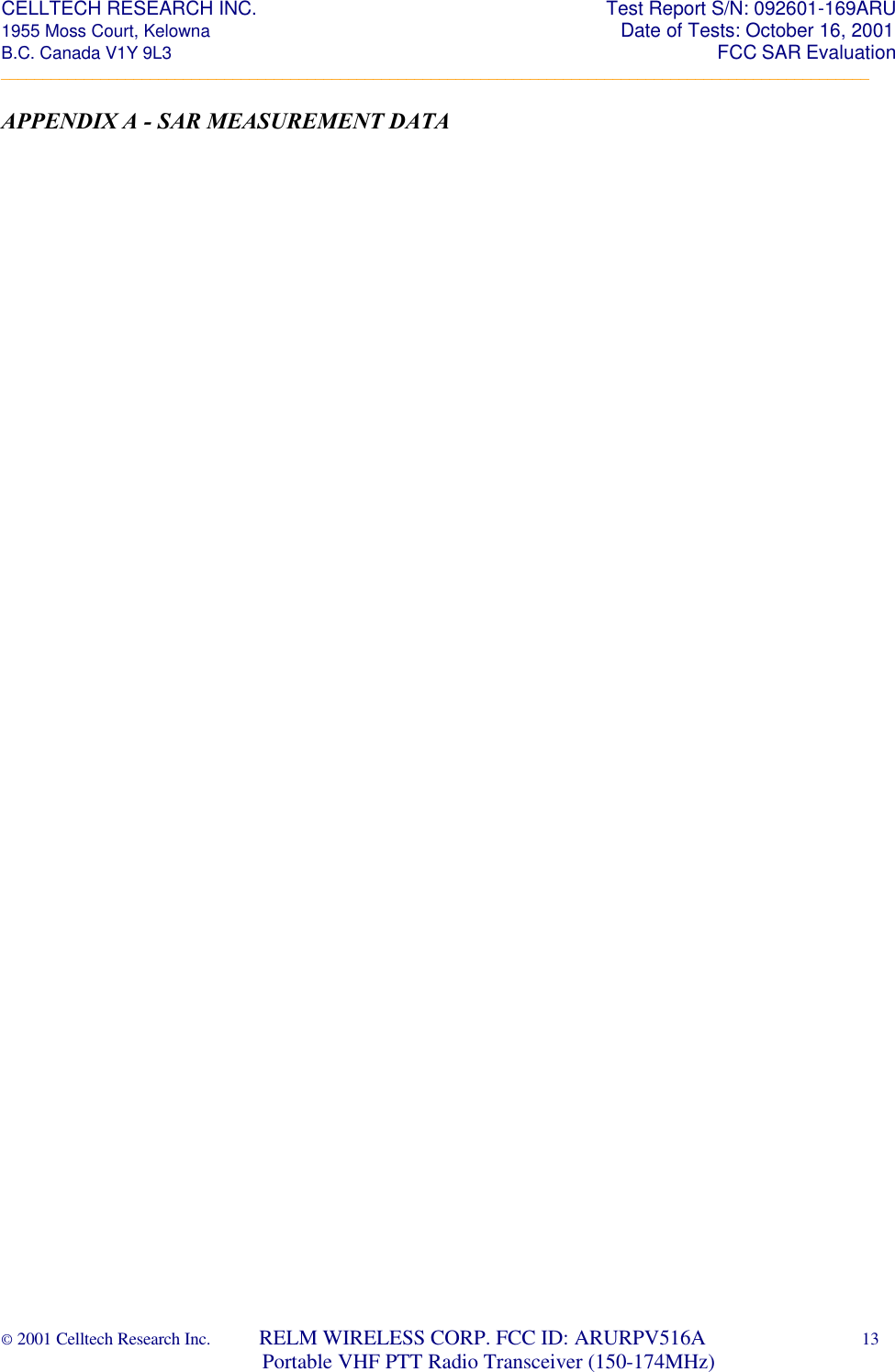
![RELM Wireless Corporation FCC ID: ARURPV516ASAM Phantom; Flat Section; Position: (90°,90°)Probe: ET3DV6 - SN1590; ConvF(7.71,7.71,7.71); Crest factor: 1.0150 MHz Brain : σ = 0.76 mho/m εr = 52.3 ρ = 1.00 g/cm3Coarse: Dx = 20.0, Dy = 20.0, Dz = 10.0Cube 4x4x7SAR (1g): 0.374 mW/g, SAR (10g): 0.282 mW/gFace SAR at 2.5 cm Separation DistanceRelm Wireless Model: RPV516AContinuous Wave ModeLow Channel (150.05 MHz)Conducted Power: 5.3 WattsDate Tested: October 16, 2001SARTot [mW/g]2.81E-28.42E-21.40E-11.97E-12.53E-13.09E-13.65E-1Celltech Research Inc.Celltech Research Inc.](https://usermanual.wiki/RELM-Communications/RPV516A.Revised-Manual-121901/User-Guide-201524-Page-16.png)
![RELM Wireless Corporation FCC ID: ARURPV516ASAM Phantom; Flat Section; Position: (90°,90°)Probe: ET3DV6 - SN1590; ConvF(7.71,7.71,7.71); Crest factor: 1.0150 MHz Brain : σ = 0.76 mho/m εr = 52.3 ρ = 1.00 g/cm3Coarse: Dx = 20.0, Dy = 20.0, Dz = 10.0Cube 4x4x7SAR (1g): 0.251 mW/g , SAR (10g): 0.187 mW/gFace SAR at 2.5 cm Separation DistanceRelm Wireless Model: RPV516AContinuous Wave ModeMid Channel (162.50 MHz)Conducted Power: 5.3 WattsDate Tested: October 16, 2001SARTot [mW/g]1.89E-25.66E-29.43E-21.32E-11.70E-12.07E-12.45E-1Celltech Research Inc.Celltech Research Inc.](https://usermanual.wiki/RELM-Communications/RPV516A.Revised-Manual-121901/User-Guide-201524-Page-17.png)
![RELM Wireless Corporation FCC ID: ARURPV516ASAM Phantom; Flat Section; Position: (90°,90°)Probe: ET3DV6 - SN1590; ConvF(7.71,7.71,7.71); Crest factor: 1.0150 MHz Brain : σ = 0.76 mho/m εr = 52.3 ρ = 1.00 g/cm3Coarse: Dx = 20.0, Dy = 20.0, Dz = 10.0Cube 4x4x7SAR (1g): 0.138 mW/g, SAR (10g): 0.104 mW/gFace SAR at 2.5 cm Separation DistanceRelm Wireless Model: RPV516AContinuous Wave ModeHigh Channel (173.95 MHz)Conducted Power: 5.3 WattsDate Tested: October 16, 2001SARTot [mW/g]9.29E-32.79E-24.64E-26.50E-28.36E-21.02E-11.21E-1Celltech Research Inc.Celltech Research Inc.](https://usermanual.wiki/RELM-Communications/RPV516A.Revised-Manual-121901/User-Guide-201524-Page-18.png)
![RELM Wireless Corporation FCC ID: ARURPV516ASAM Phantom; Flat SectionProbe: ET3DV6 - SN1590; ConvF(7.71,7.71,7.71); Crest factor: 1.0150 MHz Brain : σ = 0.76 mho/m εr = 52.3 ρ = 1.00 g/cm3Cube 4x4x7Z-Axis Extrapolation at Peak SAR LocationFace SAR at 2.5 cm Separation DistanceRelm Wireless Model: RPV516AContinuous Wave ModeLow Channel (150.05 MHz)Conducted Power: 5.3 WattsDate Tested: October 16, 200110/16/01Celltech Research Inc.0.000.100.200.300.400 10 20 30 40SAR tot [mW/g][mm]](https://usermanual.wiki/RELM-Communications/RPV516A.Revised-Manual-121901/User-Guide-201524-Page-19.png)
![RELM Wireless Corporation FCC ID: ARURPV516ASAM Phantom; Flat Section; Position: (270°,270°)Probe: ET3DV6 - SN1590; ConvF(7.65,7.65,7.65); Crest factor: 1.0150 MHz Muscle: σ = 0.80 mho/m εr = 61.9 ρ = 1.00 g/cm3Coarse: Dx = 20.0, Dy = 20.0, Dz = 10.0Cube 4x4x7SAR (1g): 0.965 mW/g, SAR (10g): 0.612 mW/gBody SAR with 1.4 cm Belt-Clip SeparationRelm Wireless Model: RPV516AContinuous Wave ModeLow Channel (150.05 MHz)Conducted Power: 5.3 WattsDate Tested: October 16, 2001SARTot [mW/g]6.86E-22.06E-13.43E-14.80E-16.17E-17.54E-18.91E-1Celltech Research Inc.Celltech Research Inc.](https://usermanual.wiki/RELM-Communications/RPV516A.Revised-Manual-121901/User-Guide-201524-Page-20.png)
![RELM Wireless Corporation FCC ID: ARURPV516ASAM Phantom; Flat Section; Position: (270°,270°)Probe: ET3DV6 - SN1590; ConvF(7.65,7.65,7.65); Crest factor: 1.0150 MHz Muscle: σ = 0.80 mho/m εr = 61.9 ρ = 1.00 g/cm3Coarse: Dx = 20.0, Dy = 20.0, Dz = 10.0Cube 4x4x7SAR (1g): 0.645 mW/g, SAR (10g): 0.468 mW/gBody SAR with 1.4 cm Belt-Clip SeparationRelm Wireless Model: RPV516AContinuous Wave ModeMid Channel (162.50 MHz)Conducted Power: 5.3 WattsDate Tested: October 16, 2001SARTot [mW/g]4.89E-21.47E-12.45E-13.42E-14.40E-15.38E-16.36E-1Celltech Research Inc.Celltech Research Inc.](https://usermanual.wiki/RELM-Communications/RPV516A.Revised-Manual-121901/User-Guide-201524-Page-21.png)
![RELM Wireless Corporation FCC ID: ARURPV516ASAM Phantom; Flat Section; Position: (270°,270°)Probe: ET3DV6 - SN1590; ConvF(7.65,7.65,7.65); Crest factor: 1.0150 MHz Muscle: σ = 0.80 mho/m εr = 61.9 ρ = 1.00 g/cm3Coarse: Dx = 20.0, Dy = 20.0, Dz = 10.0Cube 4x4x7SAR (1g): 0.138 mW/g , SAR (10g): 0.103 mW/gBody SAR with 1.4 cm Belt-Clip SeparationRelm Wireless Model: RPV516AContinuous Wave ModeHigh Channel (173.95 MHz)Conducted Power: 5.3 WattsDate Tested: October 16, 2001SARTot [mW/g]1.01E-23.04E-25.07E-27.10E-29.13E-21.12E-11.32E-1Celltech Research Inc.Celltech Research Inc.](https://usermanual.wiki/RELM-Communications/RPV516A.Revised-Manual-121901/User-Guide-201524-Page-22.png)
![RELM Wireless Corporation FCC ID: ARURPV516ASAM Phantom; Flat SectionProbe: ET3DV6 - SN1590; ConvF(7.65,7.65,7.65); Crest factor: 1.0;150 MHz Muscle: σ = 0.80 mho/m εr = 61.9 ρ = 1.00 g/cm3Cube 4x4x7Z-Axis Extrapolation at Peak SAR LocationBody SAR with 1.4 cm Belt-Clip SeparationRelm Wireless Model: RPV516AContinuous Wave ModeLow Channel (150.05 MHz)Conducted Power: 5.3 WattsDate Tested: October 16, 200111/16/01Celltech Research Inc.0.00.20.40.60.81.01.21.41.61.80 10 20 30 40SAR tot [mW/g][mm]](https://usermanual.wiki/RELM-Communications/RPV516A.Revised-Manual-121901/User-Guide-201524-Page-23.png)
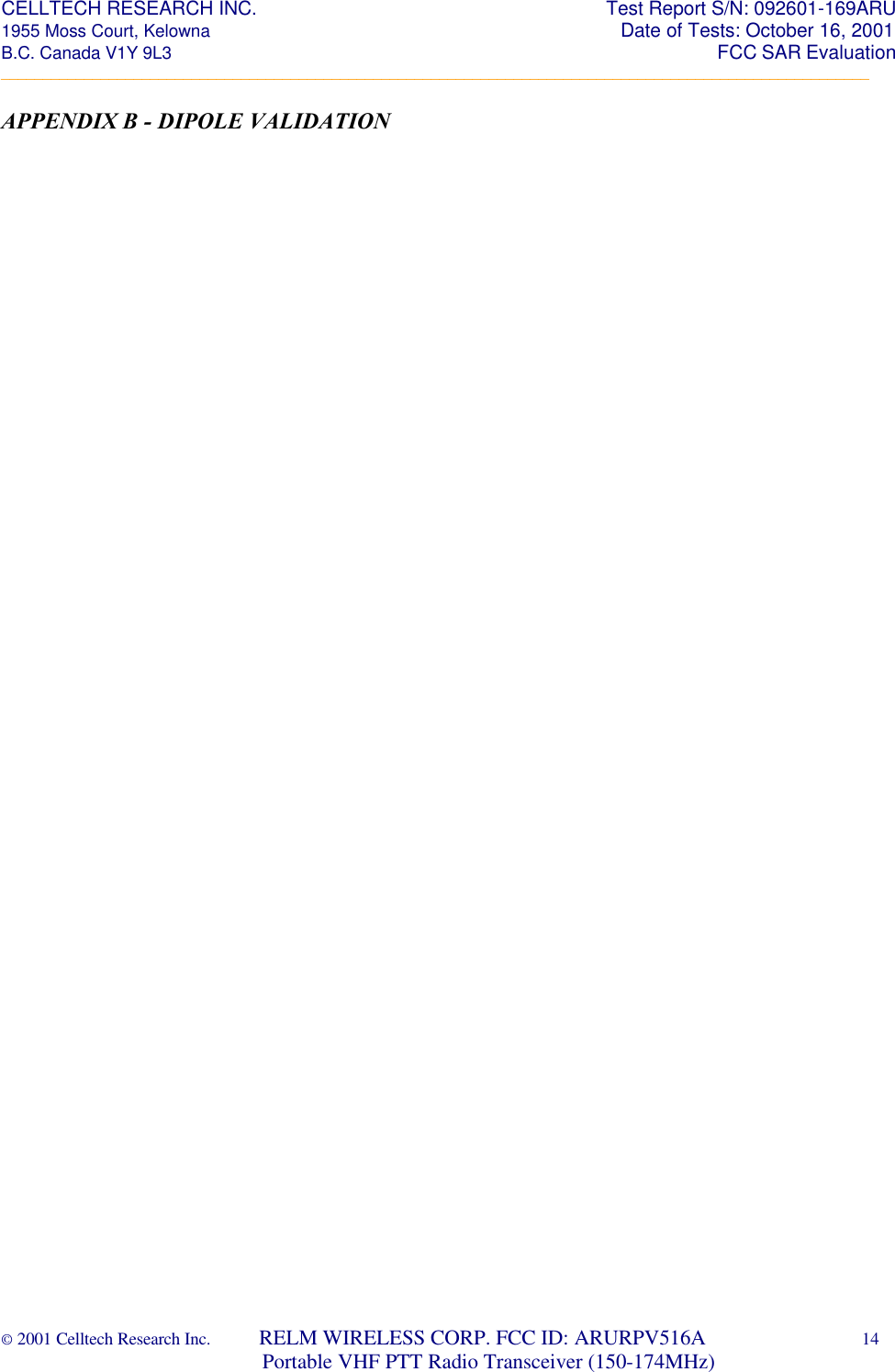
![Dipole 900 MHzSAM Phantom; Flat Section; - Validation Date: October 16, 2001Probe: ET3DV6 - SN1590; ConvF(6.83,6.83,6.83); Crest factor: 1.0; Brain 900 MHz: σ = 0.97 mho/m εr = 42.4 ρ = 1.00 g/cm3Cubes (2): Peak: 4.47 mW/g ± 0.00 dB, SAR (1g): 2.76 mW/g ± 0.00 dB, SAR (10g): 1.74 mW/g ± 0.00 dB, (Worst-case extrapolation)Penetration depth: 11.5 (10.4, 12.9) [mm]Powerdrift: -0.02 dBSARTot [mW/g]2.96E-15.93E-18.91E-11.17E+01.478E+01.77E+02.06E+02.36E+02.66E+02.96E+0Celltech Research Inc.Celltech Research Inc.](https://usermanual.wiki/RELM-Communications/RPV516A.Revised-Manual-121901/User-Guide-201524-Page-25.png)
![Validation Dipole D900V2 SN:054, d = 15 mmFrequency: 900 MHz; Antenna Input Power: 250 [mW]Generic Twin Phantom; Flat Section; Grid Spacing:Dx = 15.0, Dy = 15.0, Dz = 10.0Probe: ET3DV6 - SN1507; ConvF(6.27,6.27,6.27); Crest factor: 1.0; IEEE1528 900 MHz: σ = 0.97 mho/m εr = 42.4 ρ = 1.00 g/cm3Cubes (2): Peak: 4.47 mW/g ± 0.05 dB, SAR (1g): 2.78 mW/g ± 0.04 dB, SAR (10g): 1.76 mW/g ± 0.02 dB, (Worst-case extrapolation)Penetration depth: 11.5 (10.3, 13.2) [mm]Powerdrift: -0.00 dBSARTot [mW/g]2.50E-15.00E-17.50E-11.00E+01.25E+01.50E+01.75E+02.00E+02.25E+02.50E+006/19/01Schmid & Partner Engineering AG, Zurich, Switzerland](https://usermanual.wiki/RELM-Communications/RPV516A.Revised-Manual-121901/User-Guide-201524-Page-26.png)
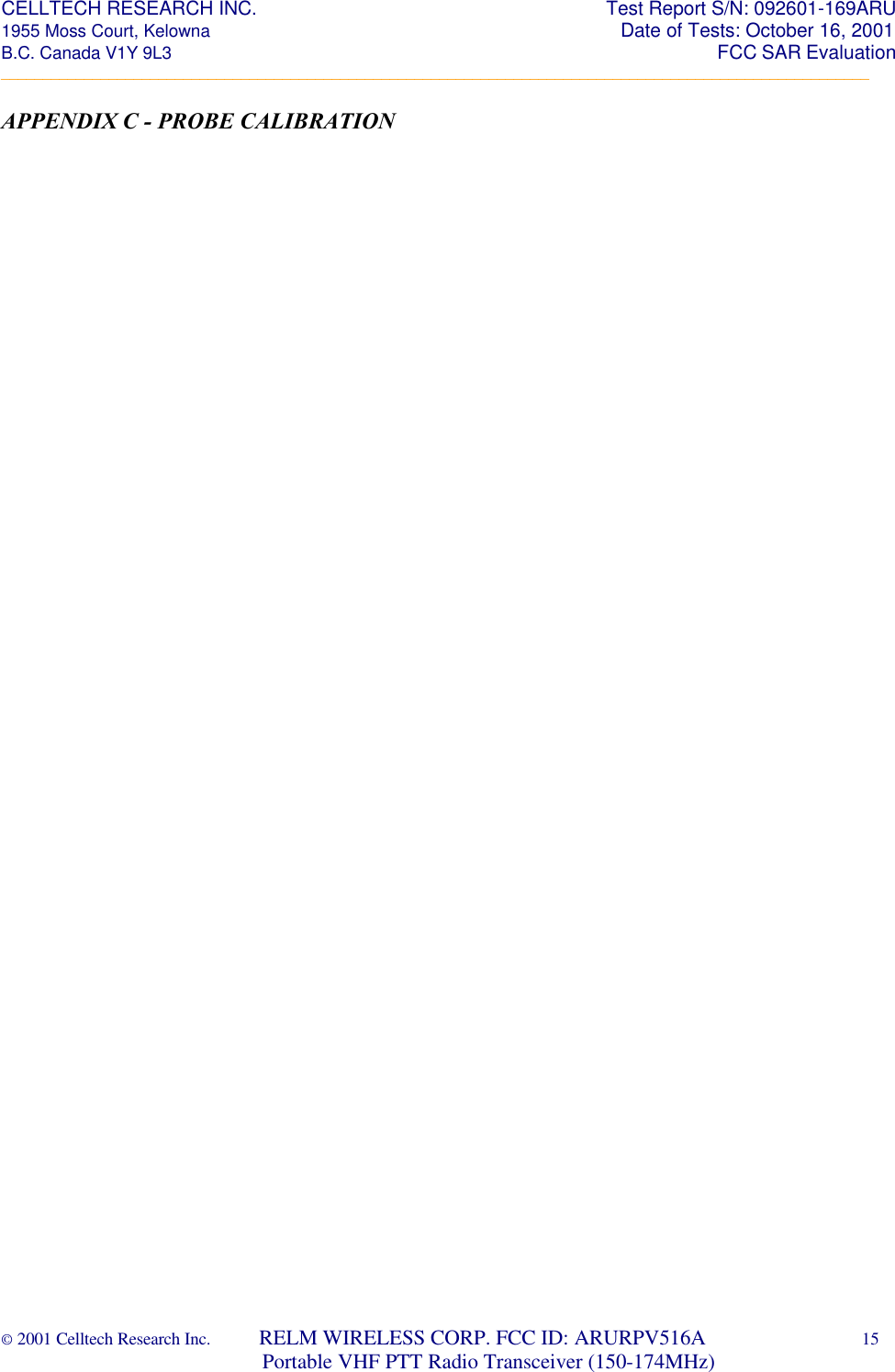
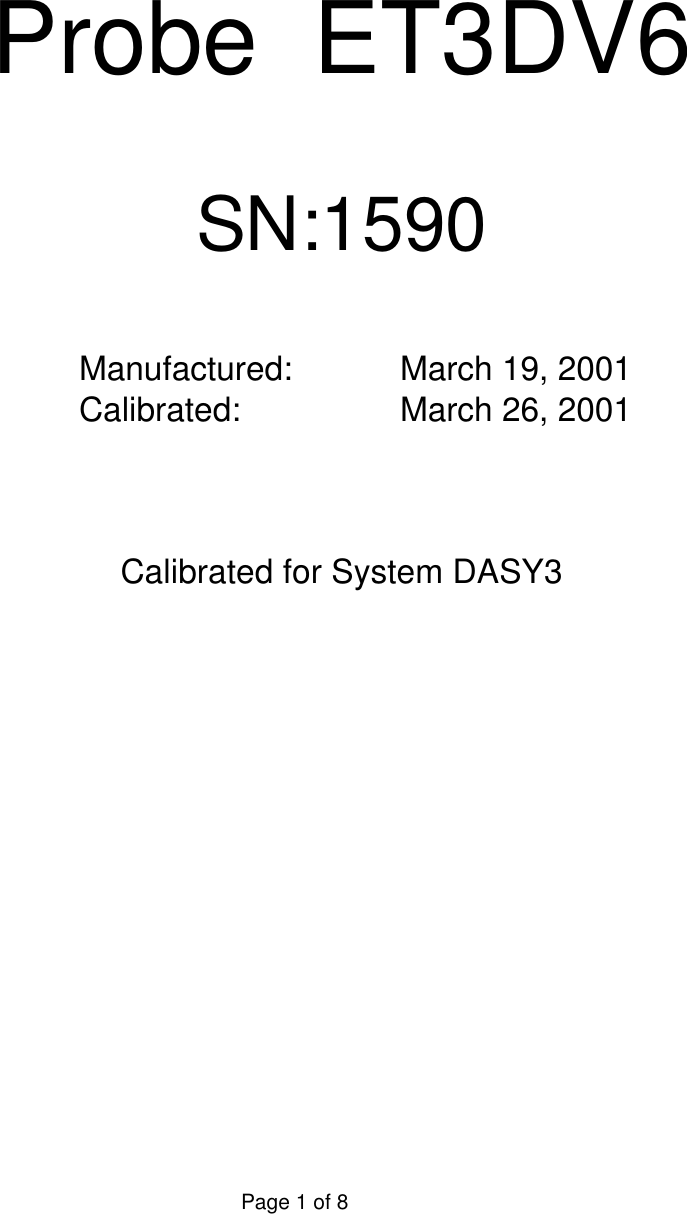
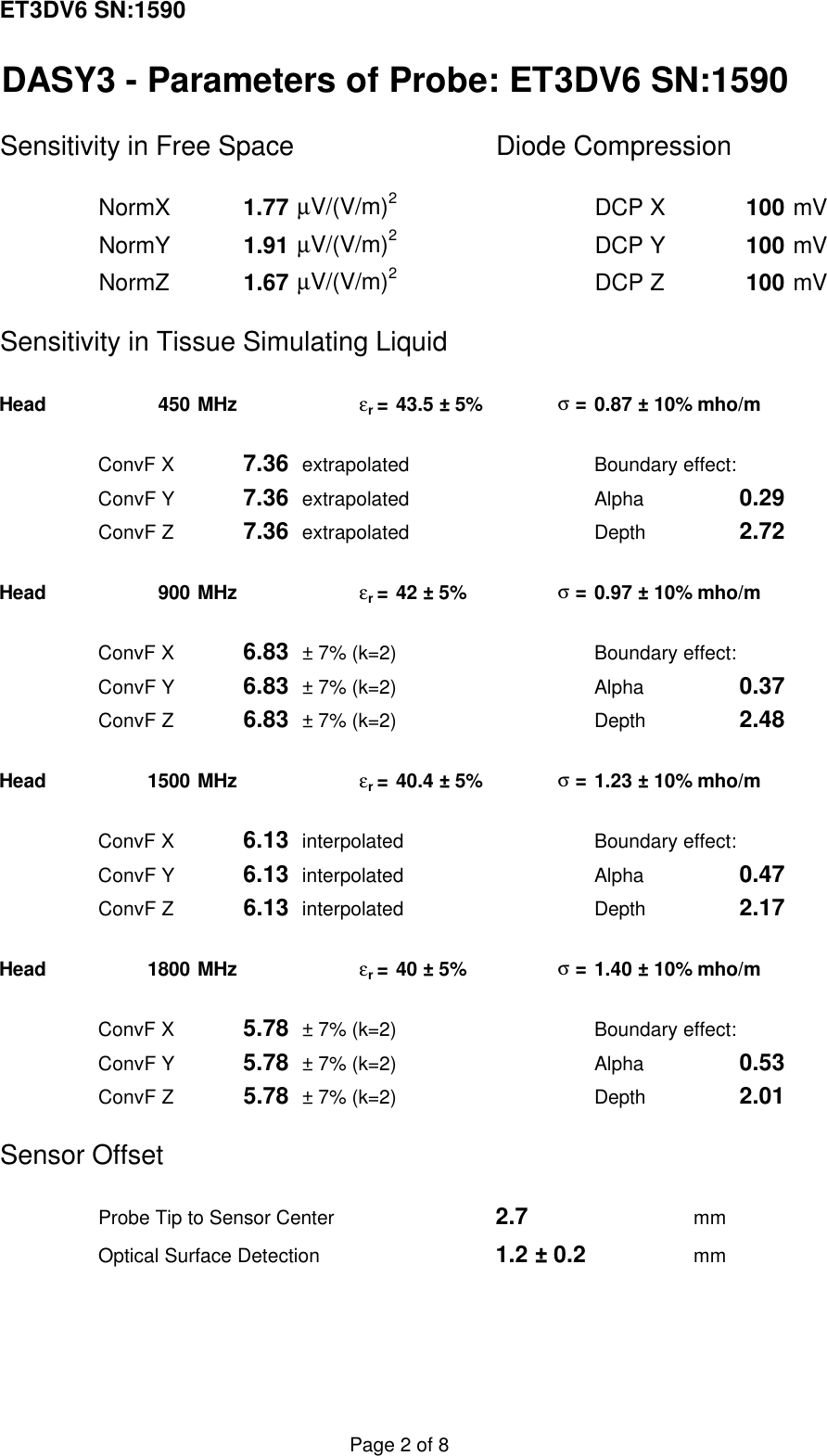

![ET3DV6 SN:1590Isotropy Error (φ ), θ = 0°-1.00-0.80-0.60-0.40-0.200.000.200.400.600.801.000 60 120 180 240 300 360error[dB]30 MHz100 MHz300 MHz900 MHz1800 MHz2500 MHzf = 1800 MHz, WG R22010 20 30405060708090100110120130140150160170180190200210220230240250260270280290300310320330 340 350XYZTotf = 2500 MHz, WG R26010 20 30405060708090100110120130140150160170180190200210220230240250260270280290300310320330 340 350XYZTotPage 4 of 8](https://usermanual.wiki/RELM-Communications/RPV516A.Revised-Manual-121901/User-Guide-201524-Page-31.png)
![ET3DV6 SN:1590Frequency Response of E-Field( TEM-Cell:ifi110, Waveguide R22)0.500.600.700.800.901.001.101.201.301.401.500 500 1000 1500 2000 2500 3000f [MHz]frequency responseTEM R22Page 5 of 8](https://usermanual.wiki/RELM-Communications/RPV516A.Revised-Manual-121901/User-Guide-201524-Page-32.png)
![ET3DV6 SN:1590Dynamic Range f(SARbrain)( TEM-Cell:ifi110 )ET3DV6 SN:15901.E+01.E+11.E+21.E+31.E+41.E+51.E+61.E+70.0001 0.001 0.01 0.1 1. 10. 100.mW/cm3µVnot compensated compensated-2.0-1.00.01.00.001 0.01 0.1 1 10 100mW/cm3errror[dB]Page 6 of 8](https://usermanual.wiki/RELM-Communications/RPV516A.Revised-Manual-121901/User-Guide-201524-Page-33.png)
![Conversion Factor AssessmentHead 900 MHz εr =42 ± 5% σ =0.97 ± 10% mho/mConvF X 6.83 ± 7% (k=2) Boundary effect:ConvF Y 6.83 ± 7% (k=2) Alpha 0.37ConvF Z 6.83 ± 7% (k=2) Depth 2.48Head 1800 MHz εr =40 ± 5% σ =1.40 ± 10% mho/mConvF X 5.78 ± 7% (k=2) Boundary effect:ConvF Y 5.78 ± 7% (k=2) Alpha 0.53ConvF Z 5.78 ± 7% (k=2) Depth 2.01ET3DV6 SN:1590f = 900 MHz, WG R9 (head)0.000.100.200.300.400.500.600.700.800.900 20 40 60z[mm]SAR[mW/cm3] / WAnalytical Measuremetsf = 1800 MHz, WG R22 (head)0.001.002.003.004.005.006.007.000 20 40 60z[mm]SAR[mW/cm3] / WAnalytical MeasuremetsPage 7 of 8](https://usermanual.wiki/RELM-Communications/RPV516A.Revised-Manual-121901/User-Guide-201524-Page-34.png)
![Deviation from Isotropy in HSLError (θ,φ ), f = 900 MHz04080120160200240280320010 20 30 40 50 60-1.00-0.80-0.60-0.40-0.200.000.200.400.600.801.00Error [dB]θφ-1.00--0.80 -0.80--0.60 -0.60--0.40 -0.40--0.20 -0.20-0.000.00-0.20 0.20-0.40 0.40-0.60 0.60-0.80 0.80-1.00Page 8 of 8](https://usermanual.wiki/RELM-Communications/RPV516A.Revised-Manual-121901/User-Guide-201524-Page-35.png)

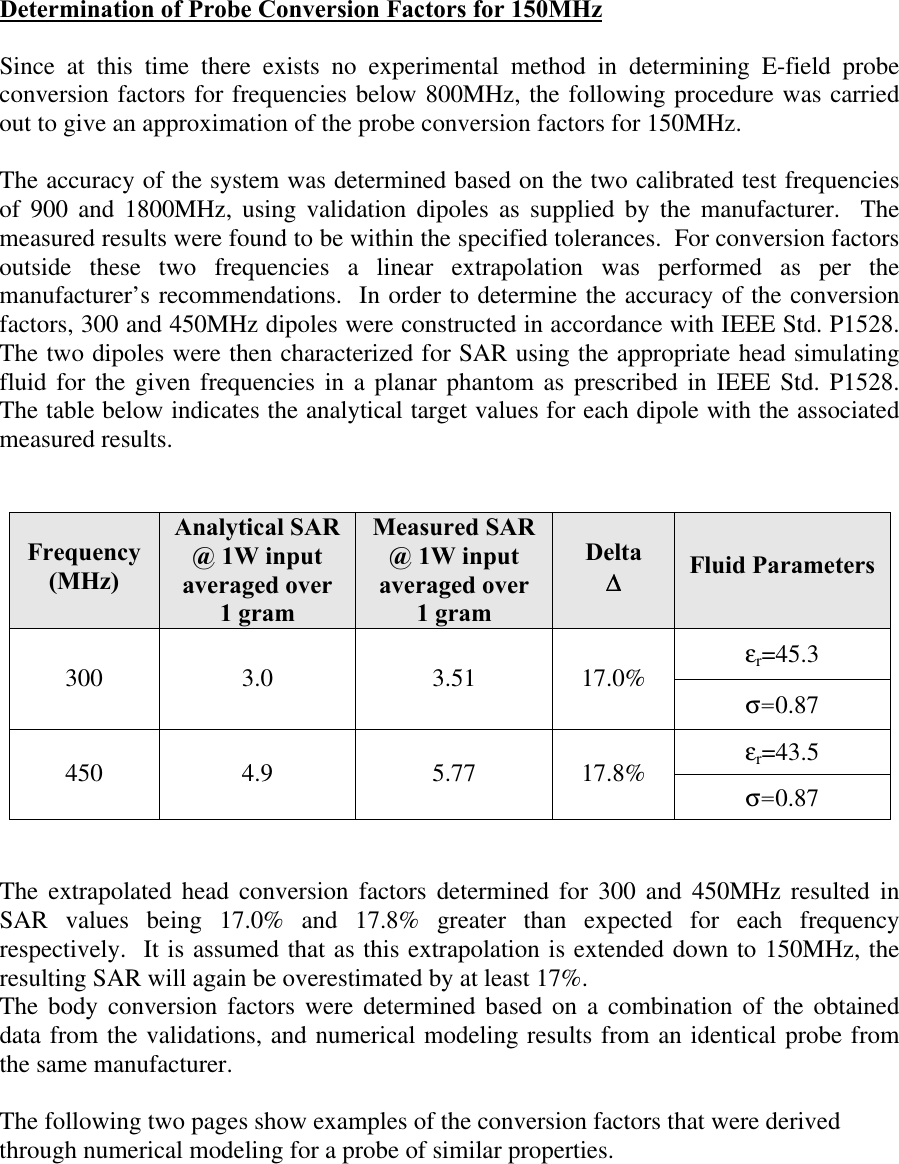
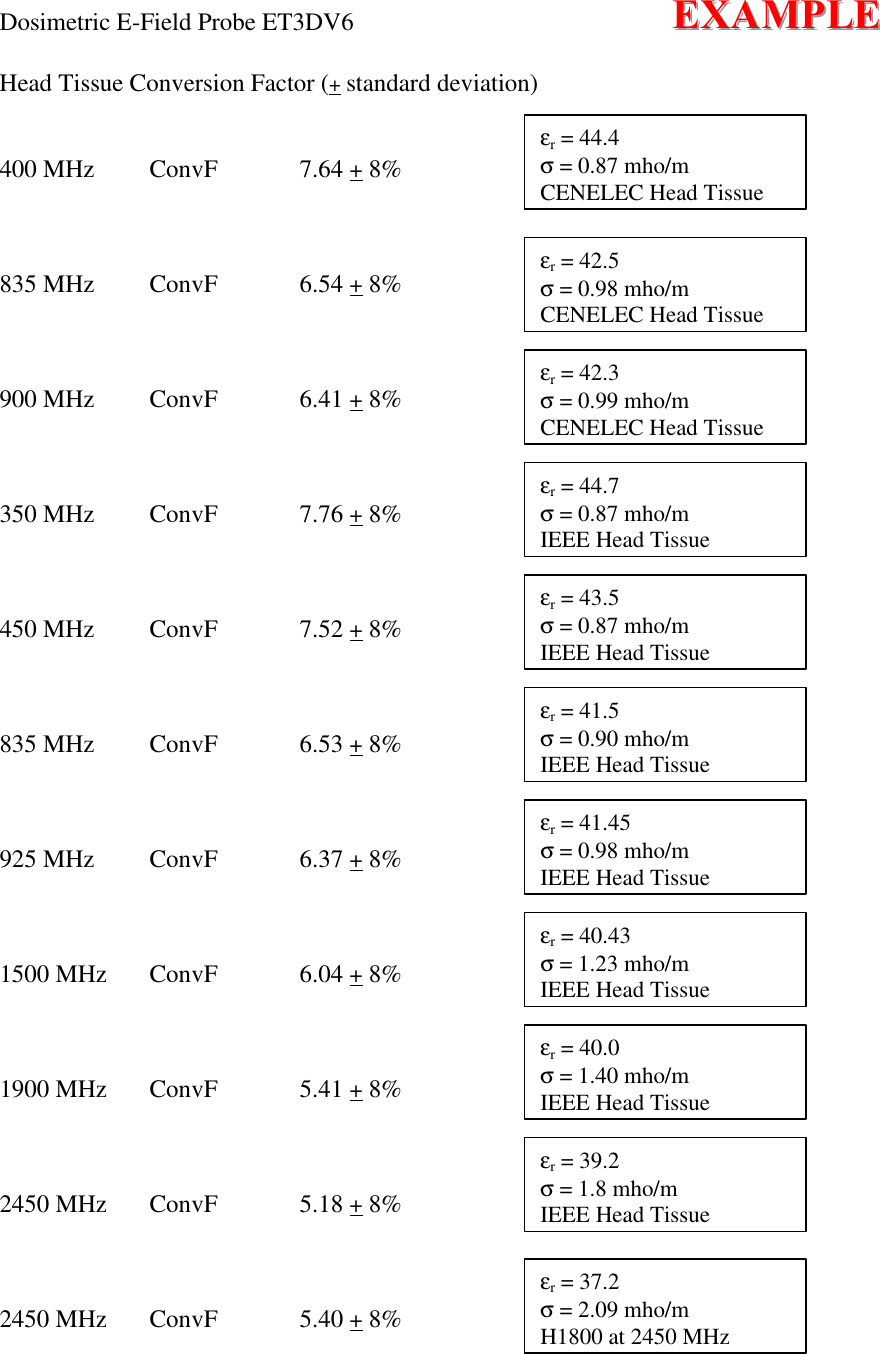

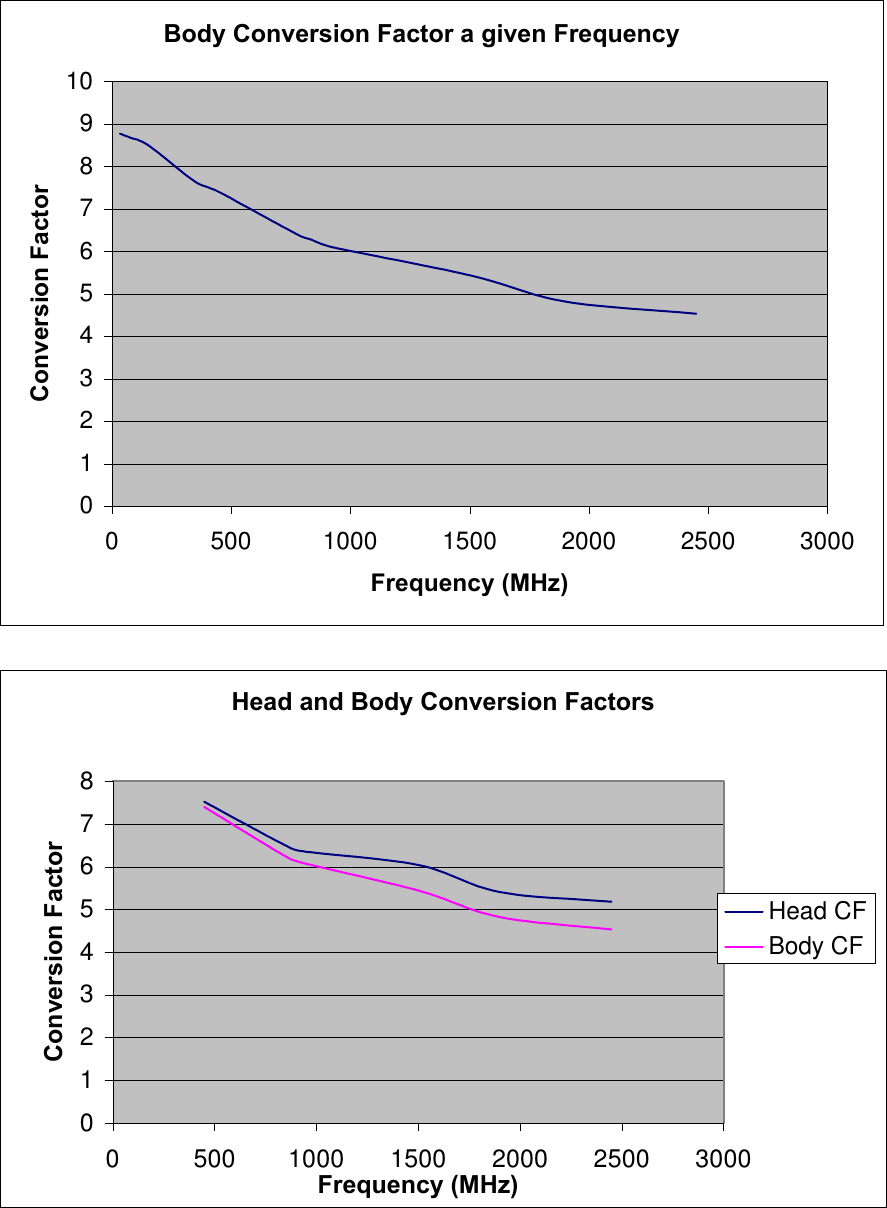
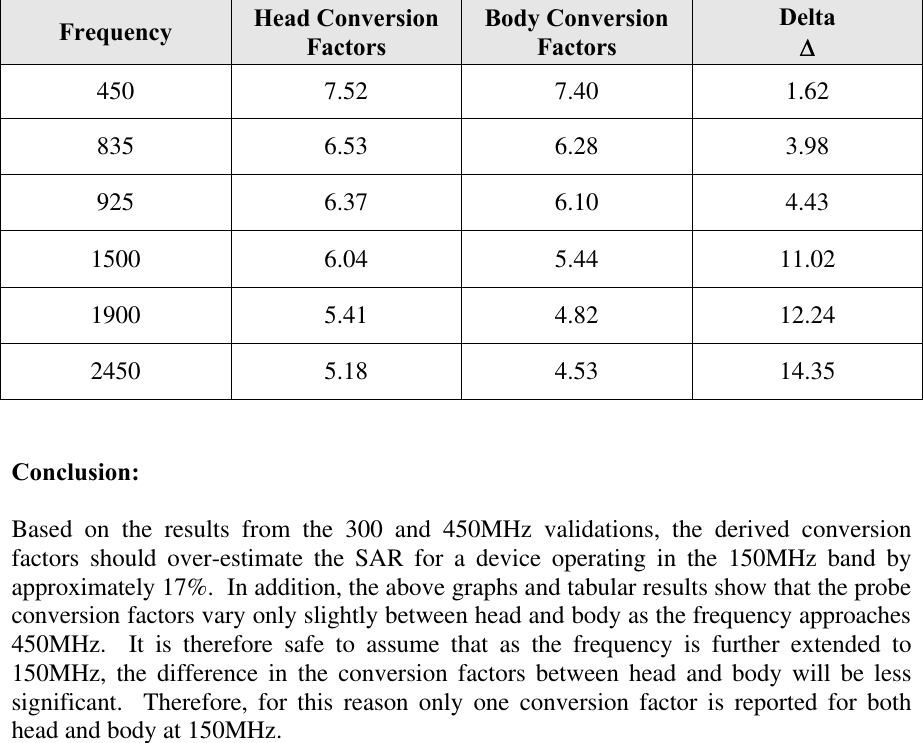
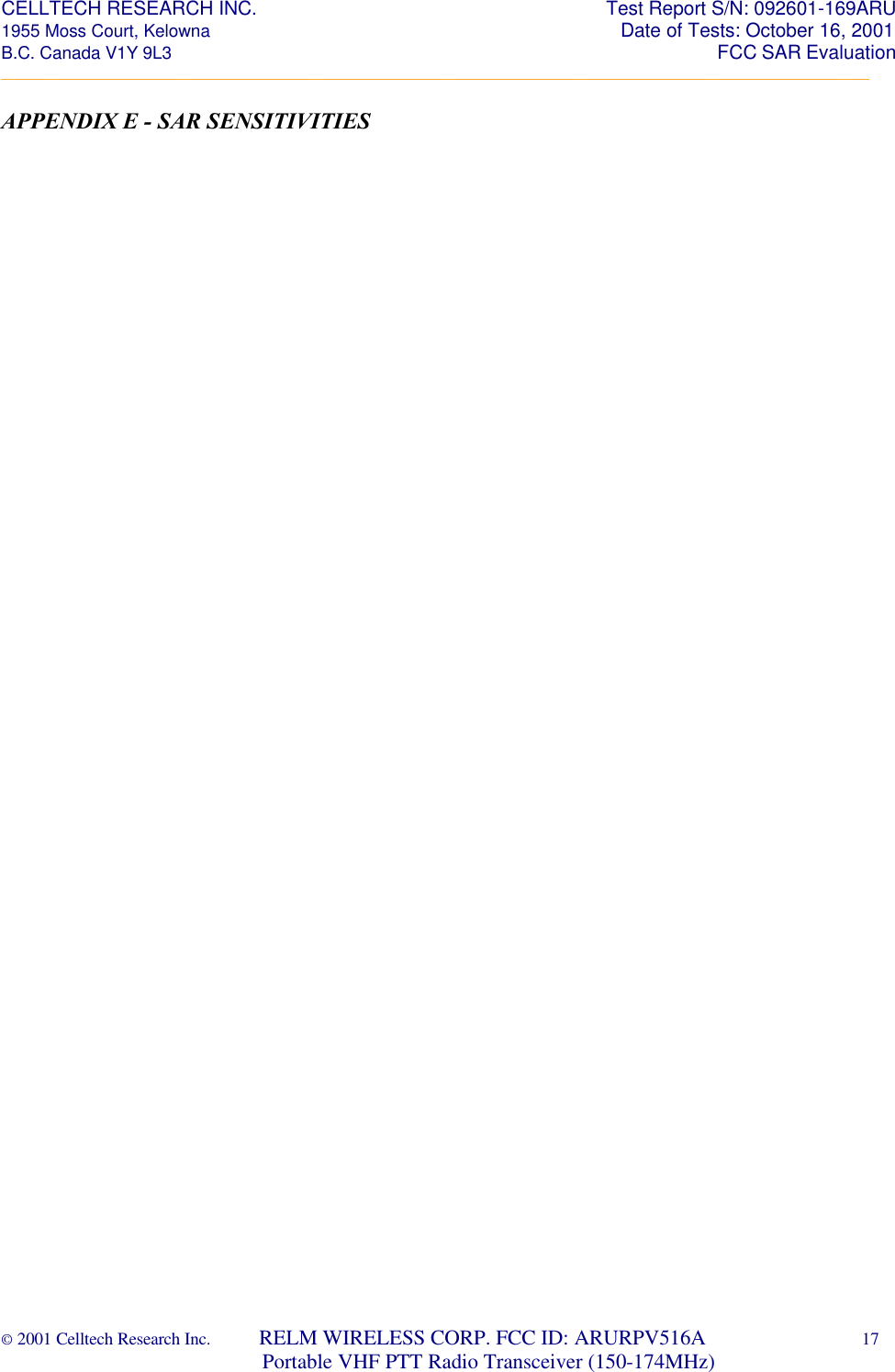
![Application Note: SAR SensitivitiesSchmid & Partner Engineering AG, Zurich, SwitzerlandApplication Note: SAR SensitivitiesIntroductionThe measured SAR-values in homogeneous phantoms depend strongly on the electricalparameters of the liquid. Liquids with exactly matching parameters are difficult to produce;there is always a small error involved in the production or measurement of the liquidparameters. The following sensitivities allow the estimation of the influence of smallparameter errors on the measured SAR values. The calculations are based on anapproximation formula [1] for the SAR of an electrical dipole near the phantom surface anda adapted plane wave approximation for the penetration depth. The sensitivities are given inpercent SAR change per percent change in the controlling parameter: d SAR / SARS(x) = ——————— d x / xThe controlling parameters x are:• ε: permitivity• σ: conductivity• ρ: brain density (= one over integration volume)For example: If The liquid permitivity increases by 2 percent and the sensitivity of the SARto permitivity is -0.6 then the SAR will decrease by 1.2 percent.The sensitivities are given for surface SAR values and averaged SAR values for 1 g and 10g cubes and for dipole distances d of 10mm (for frequencies below 1000 MHz) and 15mm(for frequencies above 1000 MHz) from the liquid surface.Liquid parameters are as proposed in the new standards (e.g., IEEE 1528).References[1] N. Kuster and Q. Balzano, “Energy absorption mechanism by biological bodies in thenear field of dipole antennas above 300 MHz”, IEEE Transacions on VehicularTechnology, vol. 41(1), pp. 17-23, 1992.](https://usermanual.wiki/RELM-Communications/RPV516A.Revised-Manual-121901/User-Guide-201524-Page-43.png)
